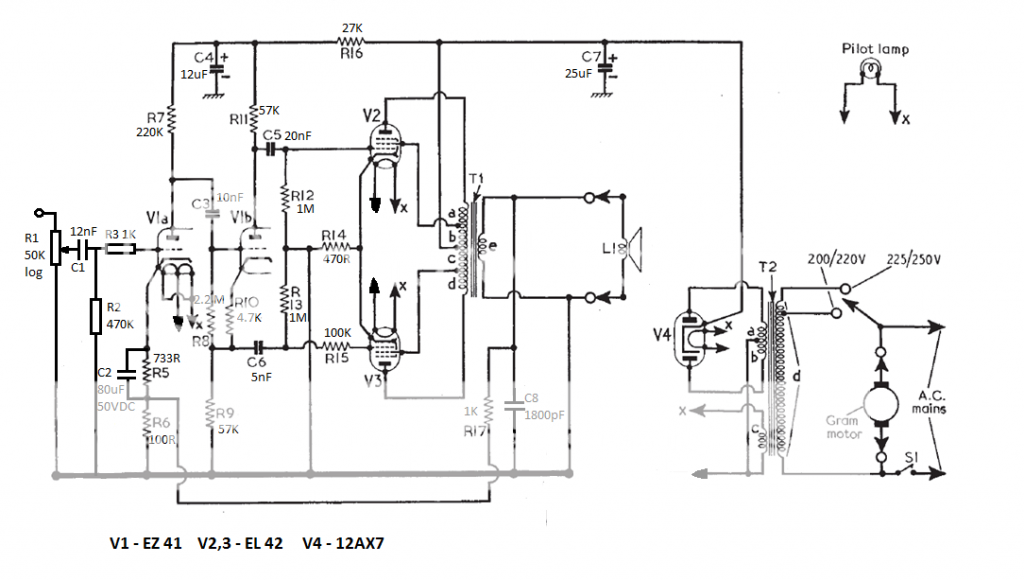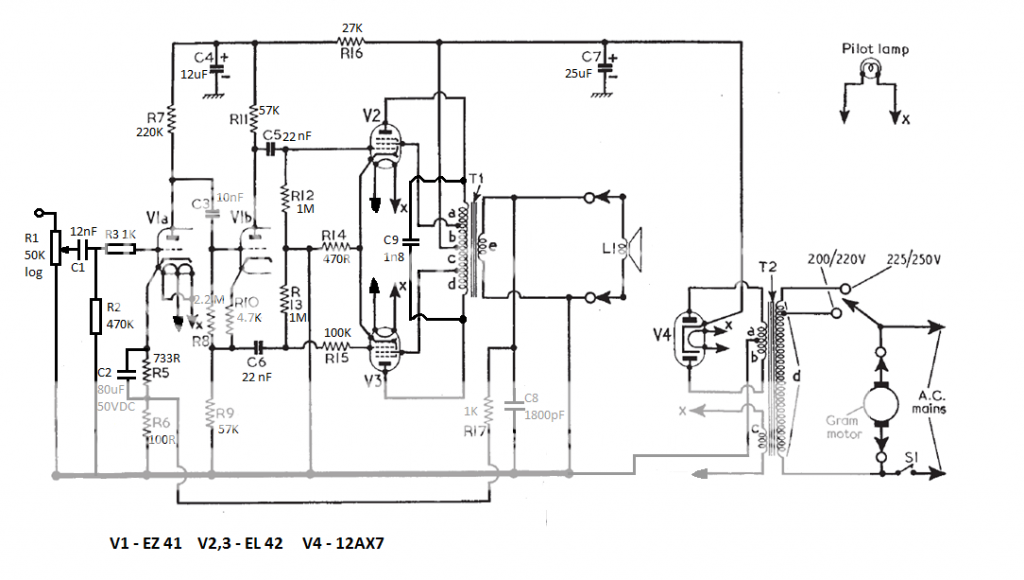Hi all, I have an old PYE Black Box amplifier from a record player that I've been meaning to use as an introduction to valve amplifiers. My intention is to create a small mono block to evaluate and possibly upgrade. Schematics are here;
http://www.radio-workshop.co.uk/service/pye-black-box-bbh.pdf
I have also been reading this thread with great interest;
http://www.diyaudio.com/forums/tubes-valves/128662-design-using-el42-output-pentodes.html
I would love to make all the changes as in the previous thread, but they have changed so much (o/p valves, o/p transformer, moved from UL to pentode and included a large choke) that I'm thinking it would have been cheaper and easier to build from scratch.
Right now I'm just after junking the tone control and setting it up for standard line level input. I have been trying to decipher the iterations in the previous thread, but get a little lost at which modification was done for which purpose. Also allot of final values are only decided after allot of modifications and as such I don't think will be suitable for my intended version.
In short I'm just looking to swap out some passive components as a quick and easy fix to the somewhat muddy sound it currently produces with crackling volume and tone controls.
Thanks in advance,
Adam.
http://www.radio-workshop.co.uk/service/pye-black-box-bbh.pdf
I have also been reading this thread with great interest;
http://www.diyaudio.com/forums/tubes-valves/128662-design-using-el42-output-pentodes.html
I would love to make all the changes as in the previous thread, but they have changed so much (o/p valves, o/p transformer, moved from UL to pentode and included a large choke) that I'm thinking it would have been cheaper and easier to build from scratch.
Right now I'm just after junking the tone control and setting it up for standard line level input. I have been trying to decipher the iterations in the previous thread, but get a little lost at which modification was done for which purpose. Also allot of final values are only decided after allot of modifications and as such I don't think will be suitable for my intended version.
In short I'm just looking to swap out some passive components as a quick and easy fix to the somewhat muddy sound it currently produces with crackling volume and tone controls.
Thanks in advance,
Adam.
Heartened to see it has a proper power transformer so it does not represent a total electrocution hazard right off the bat!  I do recommend you read both the safety and newbies threads here before proceeding.
I do recommend you read both the safety and newbies threads here before proceeding.
The obvious things to do are to replace all of the coupling caps and power supply electrolytics with new ones as they are not too likely to be good.
Next there is a very little bit of simplification you could do to delete the tone controls and current volume/loudness compensation networks..
The obvious things to do are to replace all of the coupling caps and power supply electrolytics with new ones as they are not too likely to be good.
Next there is a very little bit of simplification you could do to delete the tone controls and current volume/loudness compensation networks..
Yeah, I made sure that the chassis was earthed and connected via a good fused, 3 core lead before I did anything.
I agree about the caps, some fresh ones are likely to improve overall performance. I was thinking of Solen polypropylene 400V 12 and 25 uF, for the smoothing caps matching the originals?
With regards to the tone controls, I have drawn up a new schematic with some of the suggestions from the previous thread. I'm hoping to use this as a starting point.

In short will this configuration work as intended or are more adjustments going to be necessary?
I agree about the caps, some fresh ones are likely to improve overall performance. I was thinking of Solen polypropylene 400V 12 and 25 uF, for the smoothing caps matching the originals?
With regards to the tone controls, I have drawn up a new schematic with some of the suggestions from the previous thread. I'm hoping to use this as a starting point.

In short will this configuration work as intended or are more adjustments going to be necessary?
Last edited:
I think a 50V cap in that location will be just fine, if anything probably overkill. The voltage on that node will be no more than a couple of volts. I suspect you could safely use anything with a 6.3V rating or higher.
I'd use polypropylene coupling caps rather than PS, and I would make C5/C6 equal in value at perhaps 22nF. Remove all instances of C8 unless you want some unexpected excitement.
I'd use polypropylene coupling caps rather than PS, and I would make C5/C6 equal in value at perhaps 22nF. Remove all instances of C8 unless you want some unexpected excitement.
Heartened to see it has a proper power transformer so it does not represent a total electrocution hazard right off the bat!I do recommend you read both the safety and newbies threads here before proceeding.
The obvious things to do are to replace all of the coupling caps and power supply electrolytics with new ones as they are not too likely to be good.
Next there is a very little bit of simplification you could do to delete the tone controls and current volume/loudness compensation networks..
I remember these amplifiers and the early version pre-date electrolytic capacitors. The tank capacitors should be paper and unless they are physically damaged ought to be fine. One could place an electrolytic inside the paper case. That will help to make it look original.
As for the EL42 valves take a look at EL42 @ The National Valve Museum for more details.
Nice project.
- Status
- This old topic is closed. If you want to reopen this topic, contact a moderator using the "Report Post" button.
- Home
- Amplifiers
- Tubes / Valves
- PYE Black Box amplifier

